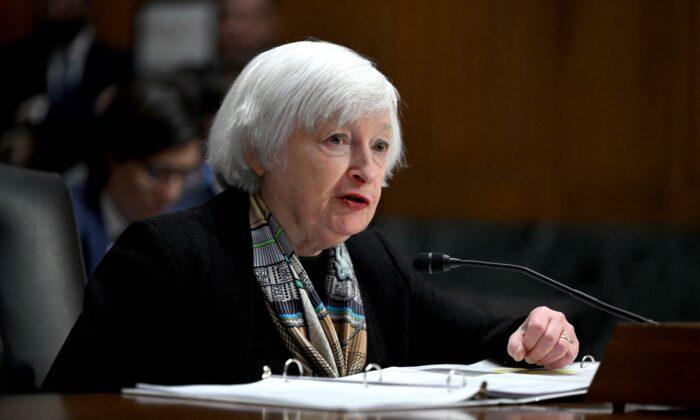Commentary
After Treasury Secretary Janet Yellen told the U.S. Senate on March 22 that federal bank regulators were not considering “guarantee of all deposits,” the stock market—and bank stocks more specifically—fell precipitously.
The next day, Yellen seemed to have walked back her comments. In a speech to the U.S. House, Yellen said that regarding insuring customer deposits, the Treasury would “be prepared to take additional actions if warranted.”
Those two days demonstrate this: The viability of any financial system is based on trust.
If trust in the financial institutions isn’t there, all bets are off.
Take First Republic Bank, for example. The San Francisco-based institution has been one of the most respected franchises in banking. It had a roster of wealthy clients, and doled out mortgages and personal loans with very low interest rates—great for their customers—during the past several years that suddenly look terrible on the bank’s balance sheet, now that rates and its funding costs are much higher.
During normal periods of rate rises, this would have meant a few quarters of poor profits for First Republic, but the bank would ultimately stay in business.
Today? It means that its stock would tank 90 percent and need rescuing from other banks.
First Republic is hardly the only bank looking shaky in an environment created by the Federal Reserve’s unprecedented rate increases. To be clear, the rate increases themselves are not unprecedented, but the speed and velocity at which these increases are done are unprecedented, and have damaged the balance sheets of all banks.
Wait—all banks you say? Then why are regional banks suffering, while the biggest ones such as JPMorgan Chase, Bank of America, and Wells Fargo are seeing their stock price go up?
Once again, it is a matter of trust.
We know that the Federal Deposit Insurance Corp. (FDIC) guarantees all deposits under $250,000. So conceptually, all bank deposits under that threshold should be safe no matter how small the bank is.
But amounts exceeding that? The view of the market and that of depositors is that they would only be safe if stored at the biggest banks—the banks considered “too big to fail”—and in the event of failure, they would be bailed out by the U.S. government.
That’s why the federal government should come out and strongly support all banks and give the perception that all bank deposits would be guaranteed. This isn’t to argue the concept of “too big to fail” is right, but since the market and investors obviously take it as a fact, then the big banks shouldn’t have an advantage simply because they are bigger.
And if the Fed or the FDIC can’t take on that role, then banks should form a consortium and create an insurance fund or their own insurance company to insure all deposits. Regardless, all deposits should be guaranteed. Consumers should not wake up one morning and find their hard-earned savings have disappeared.This needs to be done to calm the market and settle nerves, because every regional and smaller bank is now caught up in depositor panic, regardless of the health of their balance sheets or their loan holdings.
That’s unless one believes that all regional banks should cease to exist and the American banking system is better off as an oligopoly of the five biggest financial institutions. And that simply cannot be the answer. Regional and local banks are the financial backbone of our communities, offering valuable lines of credit, business loans, and real estate solutions to small businesses, proprietors, and startup ventures that the JPMorgans of the world wouldn’t work with.
Let’s be clear: This isn’t advocating for a bank bailout, or guarantee of equity owners (investors) or debt holders of the banks, but only the deposits of banks. All investors should be wiped out if a bank fails, and if bank executives or managers are reckless, they should be prosecuted. But depositors should not be punished for putting trust in their local bank.
There are plenty of critics of this, such as investor and media personality Kevin O’Leary, who argues that depositors should do their own due diligence on who they bank with. Caveat emptor, the libertarians say.
But that’s simply an unreasonable and impossible request for 99 percent of the population.
This is not investing, where an implicit level of risk is assumed. If you are buying stocks, bonds, securities, etc. there’s a nonzero chance you could lose your investment entirely. Most reasonable people understand that.
But “money in the bank,” as the old saying goes, needs to be safe. It needs to be assumed to be safe. It’s one of the only things consumers should take for granted, full stop.
The argument that your neighborhood retiree or small business owner needs to do a financial deep dive on their local bank branch before they visit to deposit their hard-earned money is preposterous.
Bank risk managers, Wall Street bank analysts, and chartered financial analysts can barely analyze bank balance sheets. And risks do change over time. A well-functioning bank six months ago can suddenly appear not to be well-functioning without warning.
So are we to ask these ordinary folks to do an MBA-level due diligence on their local neighborhood bank, and reassess their macroeconomic and interest rate outlook, every three months? Or are we to ask them to stash all of their cash under the mattress, or buy gold bars and shave a slice off each time they have to pay the construction contractor, the FedEx driver, and the food caterer?
No? Then all deposits should be insured.
It’s important to reemphasize time and again: perception is reality in banking.
We assume any cash less than $250,000 is safe. But the FDIC currently doesn’t have enough assets to cover all insured deposits (currently those less than $250,000) in the United States. As of December 2022, the FDIC held assets of $128 billion in its Deposit Insurance Fund. It can also borrow as much as $100 billion from the U.S. Treasury, and up to $500 billion with approval from the Federal Reserve.
So let’s say it can cover up to approximately $700 billion in deposits. That’s far less than the population of all insured deposits across banks in the United States. Estimates differ on the exact amount, but it’s somewhere in the neighborhood of $9 trillion.
In other words, as with any insurance company, if all of its customers simultaneously file for claims, it cannot cover everything.
So the proposed mechanics of covering all deposits above $250,000—estimated to be around $18 trillion total in the United States—isn’t all that different from the FDIC’s coverage ratio today (it would go down to 4 percent coverage ratio from 8 percent).
To summarize: The FDIC actually can’t guarantee all deposits below $250,000. But because the U.S. government has this mechanism in place, there is trust in that. It may be misplaced trust, but it does the minimum to prevent bank runs. And that’s all we are asking for today.The difference is the perception of safety and the confidence it instills. And that’s likely all it takes to calm the market down so we can all get back to business.





